Care of the environment and efficient and cheap domestic heating can go hand in hand. You get to warm up your home and still utilize absolutely clean energy if you opt for the best propane heater. It’s no secret that these devices are by far one of the most effective ones. But lack of knowledge on how they work and how to operate them, fool people into thinking they shouldn’t buy one.
That’s why our crew has compiled this thorough guide on how to utilize propane energy for residential heating. Not only that we will educate you on the most important aspects but we will also provide you a list of the top available propane heater reviews. See our safety tips and discover how to maximize the effect of your brand new heater. Don’t waste any more time, scroll down.
See The Quick Comparison Chart
Things to Consider Before Buying a Propane Heater
Now that you have extensive knowledge on how to safely and effectively use your domestic propane heater it is time to actually find out which characteristics will fit your needs. This section will guide you through the process of selecting the unit which will help you the most. While many other properties can also be mentioned, the ones which we have highlighted are the difference makers. Heating a house with propane doesn’t need to be a challenge at all.
Size and Portability
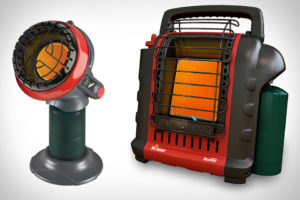
Portability is both a blessing and a curse when we talk about the pros and cons of propane energy. You do not require any cables or cords to run your heating but you do require a connection to a gas tank. This will, of course, limit you when looking to move your heater. If you have a central system and a number of gas outlets and pipes around your home, then you can perhaps switch the location of your unit.
This all goes out of the window in the case of propane wall heaters. Unless you are willing to go through dismounting it and mounting it again, then you must forget about relocating a wall heater. Some models have feet and are freestanding. Others, such as the propane patio heaters have a slot for a propane tank meaning that they can go anywhere because the connection isn’t an issue. Those are exclusively for outdoor use only, though.
Location
Indoor propane heaters are best mounted near a window. This will ensure a warmer draft and less heat dissipation through the window. Putting the unit there will also make it easier to vent. Tightly closed areas are not recommended when using such a device. You want to have quick and easy access to air and the window is your best shot.
Now, infrared propane heaters are not so pretentious because in general, they are ventless meaning that no fumes are emitted and that you don’t need to aerate the room all the time. These can be put anywhere but you still might feel the smell of gas once in a while.
Outdoor heaters simply must be used where their name tells us to be used – outdoors. Anything else you do with them is a safety hazard.
Ignition
There are two main types of ignition when we talk about portable propane heaters. The first one is the manual ignition and it is pretty much obsolete. It requires that you start the gas regulator and then light the flame manually using a lighter or a match. The best brands and manufacturers nowadays avoid making such units. This process can be dangerous and you want no part in it.
The second type is actually the right way to light a propane heater and it is far safer. The so-called Piezo ignition is a mechanism thanks to which the user doesn’t need to interact with fire, flames, sparks, and other cool-sounding but dangerous phenomena. This process consists of pressing a knob and pushing a button. It all happens inside the tube and is practically invisible to our eyes. The Piezo ignition uses a small electric charge to ignite the gas. The only downside is that this automatic mechanism will wear down in time and might need repairs.
Functions
Easiness and comfort are crucial when it comes to people’s domestic heating. You want to have control and convenience. This is why the best heaters out there should have some of the following:
Built-in Fan
While it is great to have radiating heat, it is also nice to have something to blow it around. This way an infrared propane heater will heat up not just the objects and people but also the air. A great addition to any unit
Thermostat
If it comes with the heater then great. Not a lot we can add here. Use it to control the amount of heat you get out of your unit.
More Burner Tiles
It’s not only about having more and more heat. It is also about deciding how much you want at any one time. The finest models will not have all burner tiles turned on if you don’t want them to be on. This means you get the right amount of heat and also save on fuel.
Piezo ignition
We have already covered that in the previous paragraph.
Safety
Safety is typically the number one priority of all propane heater users. If you missed our extensive safety tips above, we strongly recommend that you go back and read them before commencing to buy a liquid gas heater. Especially for your peace of mind, a device should have some of these safety components:
Low Oxygen Shut-off
This function is pretty self-explanatory. If the area is tight, if oxygen is low, the unit will be smart and will not blow up. Pretty useful.
Tip-over Switch-off
Again, a measure preventing disaster. This time it is about the unit not making a mess in case it falls over.
Swivel Regulator
This is a great addition as it takes care of the connection. You want the fuel hose to be as tight and as safe as possible. That’s what this gadget does.
- Invisible
Fuel Compartment
This part should be hidden and no one should have direct access to it.
Protective Grid
Infrared heaters as well as natural gas heaters should have a few metal pieces separating the flames from the outside world. Reaching in and touching these parts isn’t the best of ideas.
High-Temperature Switch-off
Pretty simple, heat goes out of control and the unit shuts off.
Best Propane Heaters Comparison Chart
| PRODUCT | DETAILS | ||
|---|---|---|---|
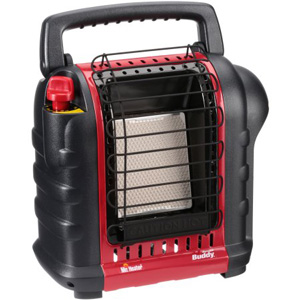 | Mr. Heater Buddy Portable Propane Heater |
| View On Amazon |
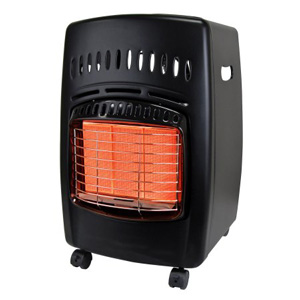 | Dyna Glo 18,000 BTU Propane Heater |
| View On Amazon |
 | Dura-Heat Propane Convection Heater |
| View On Amazon |
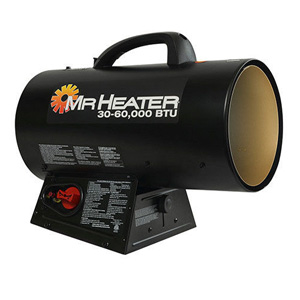 | Mr. Heater Portable Propane Heater |
| View On Amazon |
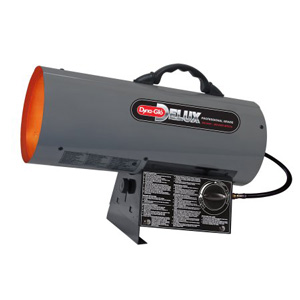 | Dyna-Glo Liquid Propane Forced Air Heater |
| View On Amazon |
Best Propane Heaters (New List)
1. Mr. Heater Buddy Portable Propane Heater

The maximum space you will be able to heat up is 225 square feet. This goes to show that if you want portability, you simply cannot get an enormous, powerful heater. Going camping isn’t a challenge as you get piezo ignition – easy to start. You also have a folding handle so that moving the unit can be easy. It is somewhat an advantage that you can connect the unit to a large 20 lb. propane tank, but the filter and the hose are sold separately.
2. Dyna Glo 18,000 BTU Propane Heater

There will be no struggles to light the device as it features a Piezo ignition – just press the button. There are three burners – 6000 BTU each. At the lowest setting, you have just the middle one running. It is best if you use the heater at a properly-ventilated place. It does, however, have an Oxygen Depletion Sensor so your safety won’t be compromised indoors. There are handles on the side and along with the casters, you can easily move the unit to your RV, camp, or workshop.
3. Dura-Heat Propane Convection Heater

The base of the unit also accommodates the dial and the button for the pilot light. Auto safety shut-off is a key feature and the unit will switch off if it tips over. You get a 10-foot hose included in the set. One thing to keep in mind, however, is that the heater needs to be used at well-vented places. It will be a nice tabletop patio heater.
4. Mr. Heater Portable Propane Heater

Efficiency is truly the name of the game here as you can keep the machine going for about 14 hours using just one tank. At 60 000 BTU which is the maximum output of the unit, you will be able to heat up to 1500 square feet of space. Safety isn’t an issue here. The appliance has thermoelectric safety valves and some high limit switches which will prevent it from overheating.
Such a powerful device, as it is one of the best propane garage heaters available in the market, simply cannot be silent although you will be happy to find out that the noise levels are rather low in comparison to other models in the same class.
5. Dyna-Glo Liquid Propane Forced Air Heater

The 10 ft. hose and the propane filter are both included in the set. You only have to decide on the capacity of the heater. Your options vary from 40 000 BTU units to 300 000 BTU. Enormous spaces can be heated with just one unit if you opt for the most expensive option. More specifically, up to 7000 square feet. You will struggle to find a more powerful propane heater. The thermostat and the tip over switch-off will take care of your safety while working.
Safety is Always Crucial with Propane Heaters
We simply cannot start talking about efficiency, money-saving, and popular characteristics before we extensively cover how to safely use your indoor propane heater. Our crew has compiled this section below especially for your own peace of mind.
All the cool benefits of the best-vented propane heater mean nothing if you run it wrongly and dangerously. The things to be careful about are more than a dozen and right now we will try to cover all your bases. Things can always be added to the list, of course.
If Your Propane Tank Is Outside
- The tank needs to stand on very stable ground. That’s the short explanation. It is an important thing to keep in mind because a tilted tank is a pretty dangerous occurrence. The hose and the regulator might come undone and that definitely bears plenty of dangers. Furthermore, realistically keeping track of how much gas you have left is pretty hard if the liquid isn’t laying evenly inside that tank.
- Make sure you are familiar with the local regulations regarding distance and tank placement. You want your propane tank to be located at a proper distance from property lines and other structures. Consult experts if you have to.
- Place the outdoor tank in such a way that it is protected from any sort of collisions or impacts. You can’t have vehicles driving right by it. Use plastic or wooden covers if you want to prevent any objects from falling on it.
- Rigid pipes should be used between the tank and the building. Once the installation moves indoors flexible tubes can be used – but never outside. With all the unpredictability related to climate, weather, domestic animals, people, etc. you simply cannot have flexible gas connections outside. They are too soft.
- Look for a certified technician to verify that all the connections are done properly. It is not only about tightness. It’s also about rules you might not be familiar with.
- It is imperative that nothing combustible is left within 10 feet of the propane tank. The problem isn’t that stuff might catch fire because of the gas but it’s the other way around. Combustible things may turn out to be the reason why fire reaches the tank. No need to explain further.
If Your Tank Is Indoors
- Firstly, propane tanks or cylinders have to be transported in an upright position. While this is not directly linked to the use of a propane heater at home, you will need to change the tank every once in a while. Taking good care of it when transporting it shows your overall attitude.
- Smaller tanks are the way to go when we are talking about indoor storage. Don’t ever think about putting a 100 lb. the gas tank inside of your home. Go with a smaller one – maybe 20 lb. In the event of an accident, the damages and the aftermath will be far less significant.
- Make sure there are no dings and dents on the gas tank. We can’t stress enough how important the integrity of this item is. Any little visible damage might lead to catastrophic consequences and it is completely up to you to make sure that the body of the tank is intact. Areas such as workshops are often heated by similar units. Getting a propane heater for your garage is a great idea as long as you are careful when swinging those tools around it. This goes for all items which function under pressure.
- How you connect your manifolds also matter greatly. If you are relying 100% on liquid gas heating for your home then this means that you will require more than one manifold. Make sure to keep them separated by at least 20 feet of space. Another important tip concerning this type of installation is to never connect more than 3 100-lb. tanks to one manifold.
- Although checking for leaks can be done by a professional, you can do it as well. Just make sure to never use water and soap. They have a corrosive effect and this will be detrimental to the gas system, the tank, and the connections. There is a special leak detector solution that is designated to, obviously, locate gas leaks.
Safety Tips On Indoor Propane Heaters
Now that we discussed safety measures related to gas tanks, we will share a few words on how to take care of your heater. More often than not, people go for a ventless propane wall heater with a blower. This is exactly the type of heater we also encourage you to consider for your home but that doesn’t mean there aren‘t any hazards.
- What do we say about all heating and cooling systems which we review? Size matters. Surely this is the case here as well. The size and the power of the heater should correspond to the size of the room you are having heated. This is an important safety aspect because a very powerful propane heater will turn out to be dangerous for the surrounding objects. Besides, a larger indoor propane heater with the thermostat will force you to keep objects at a bigger distance from it. This isn’t possible if your room is just 100 square feet.
- Secondly, don’t keep any potentially flammable materials close to your propane heater. Let’s not forget that all high-quality infrared heaters will first heat up objects and only after that the air. Combustibles should be kept away from the direct.
- Furthermore, the finest vented propane heaters should have a safety shut-off valve. This component switches off the intake of gas if the hose is loose or if the heater is tilted.
- Ventilation matters. Yes, they tell you that those high-class infrared propane heaters are completely ventless but you can always stay on the safe side. Make sure you open the windows regularly and ensure there’s enough air when changing the gas tank. Also, ventilation is also important when looking to prevent the accumulation of carbon monoxide.
- Since we mentioned carbon monoxide, it is important to note that it can be quite dangerous if you are a sloppy owner. A carbon monoxide detector is a device you want to buy. It will monitor the levels of the substance and will alert you.
- Repairs shouldn’t be attempted by just anyone. If anything goes wrong with your heater, simply call a specialist and allow them to work their magic. Unless you are certified, you shouldn’t try and troubleshoot your domestic propane heater.
- It is important that when you want to move the heater or switch the tank to shut off the tank first. Stop the whole gas supply and only then turn the heater off. This will ensure cleaner tubes and pipes as all the residual propane will have left the system. You want completely clean and empty pipes when you are doing any sort of relocations or substitutions.
Getting The Most Out of Your Propane Heater
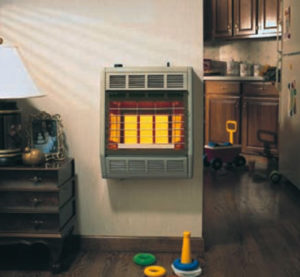
- Firstly, maintain your heater or heaters often and do it properly. It is best if you get a contractor to do that for you. The difference between a licensed technician and a contractor is that the latter will do that year-round and you will end up getting a better price.
- Speaking of better prices, ask your propane supplier whether you can get an annual plan. Companies will offer great prices to homeowners who are also regular clients. This way you will avoid the higher bills in the winter and will enjoy a steady price for your propane.
- Sealing your home properly is one of the key reasons why you will get efficient heat. This literally goes for every type of heater regardless if it is the best bathroom heater or a top-notch garage heater. Moreover, hire professionals to seal your windows, baseboards, and even maybe insulate your walls. These investments will go a long way when we talk about domestic heating with propane.
- Control not only your heater but also yourself and your family. Furthermore, you do not need to crank up the thermostat all the way up. Make sure you get a comfortable temperature and there’s no need to go over it. Additionally, just put on a sweater and lower the temperature controller by a degree or two.
- Ventilation and fans are useful but they also have one drawback. Fans will refresh the air and will prevent moisture from spreading but they will also suck the warmth out. Make sure you use as much venting as needed. Once you are out of the kitchen or the bathroom, turn the ventilation off.
- Furniture should be rested on the outside walls. This way you will not feel that many cool drafts. The furniture will absorb it.
- Lastly, heat also dissipates through windows and glass. What you can do to prevent it is to get shades, blinds, curtains, etc. The more things and decorations you have on your windows, the warmer the room will remain.
Wrapping Up
This was quite a lot of synthesized information we brought you but you can’t have it any other way when you want to get the best propane heater for your domestic convenience. We hope that we’ve assisted you greatly in your hunt to purchase the best unit available. Also, don’t forget any of the safety tips we shared as they are really the most important aspect of this type of heating.
In case you think we missed a point in our propane heater reviews, please feel free to let us know either via email or by commenting on the article. If you suggest that the guide was useful, share it, and make sure to also see our input on other forms of heating and cooling. Thanks for reading and as always – stay put!
Leave a Reply